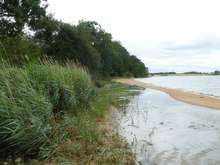Ramsholt Cliff
| Site of Special Scientific Interest | |
 | |
| Area of Search | Suffolk |
|---|---|
| Grid reference | TM 297 427 [1] |
| Interest | Geological |
| Area | 2.1 hectares[1] |
| Notification | 1987[1] |
| Location map | Magic Map |
Ramsholt Cliff is a 2.1 hectare geological Site of Special Scientific Interest north-west of Ramsholt in Suffolk.[1][2] It is a Geological Conservation Review site,[3] and it is in the Suffolk Coast and Heaths Area of Outstanding Natural Beauty.[4]
This site is very important historically because it was the basis for the distinction of the Pliocene Coralline Crag Formation as a new stratigraphical division by the nineteenth-century geologist, Edward Charlesworth. The well preserved fossils include several unusual species.[5]
Most of this steeply sloping site on the bank of the River Deben is inaccessible, but a footpath runs along the top and a track leads to a small area of bank.
References
- 1 2 3 4 "Designated Sites View: Ramsholt Cliff". Sites of Special Scientific Interest. Natural England. Retrieved 26 June 2017.
- ↑ "Map of Ramsholt Cliff". Sites of Special Scientific Interest. Natural England. Retrieved 26 June 2017.
- ↑ "Ramsholt Cliff, Ramsholt (Neogene)". Geological Conservation Review. Joint Nature Conservation Committee. Retrieved 26 June 2017.
- ↑ "Suffolk Coast & Heaths Area of Outstanding Natural Beauty Management Plan 2013–2018" (PDF). Suffolk Coast & Heaths AONB. p. 76. Retrieved 6 August 2016.
- ↑ "Ramsholt Cliff citation" (PDF). Sites of Special Scientific Interest. Natural England. Retrieved 26 June 2017.
This article is issued from
Wikipedia.
The text is licensed under Creative Commons - Attribution - Sharealike.
Additional terms may apply for the media files.